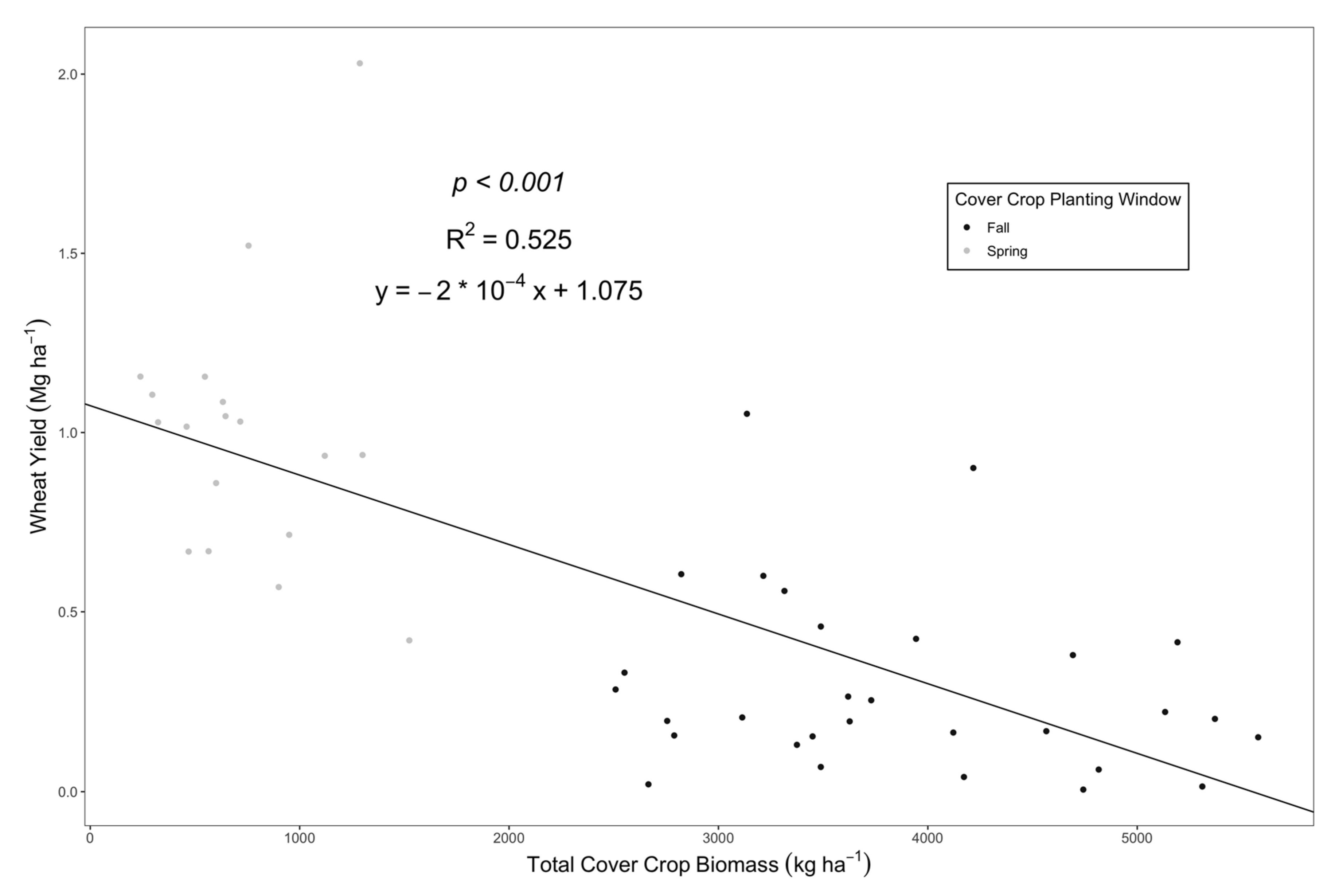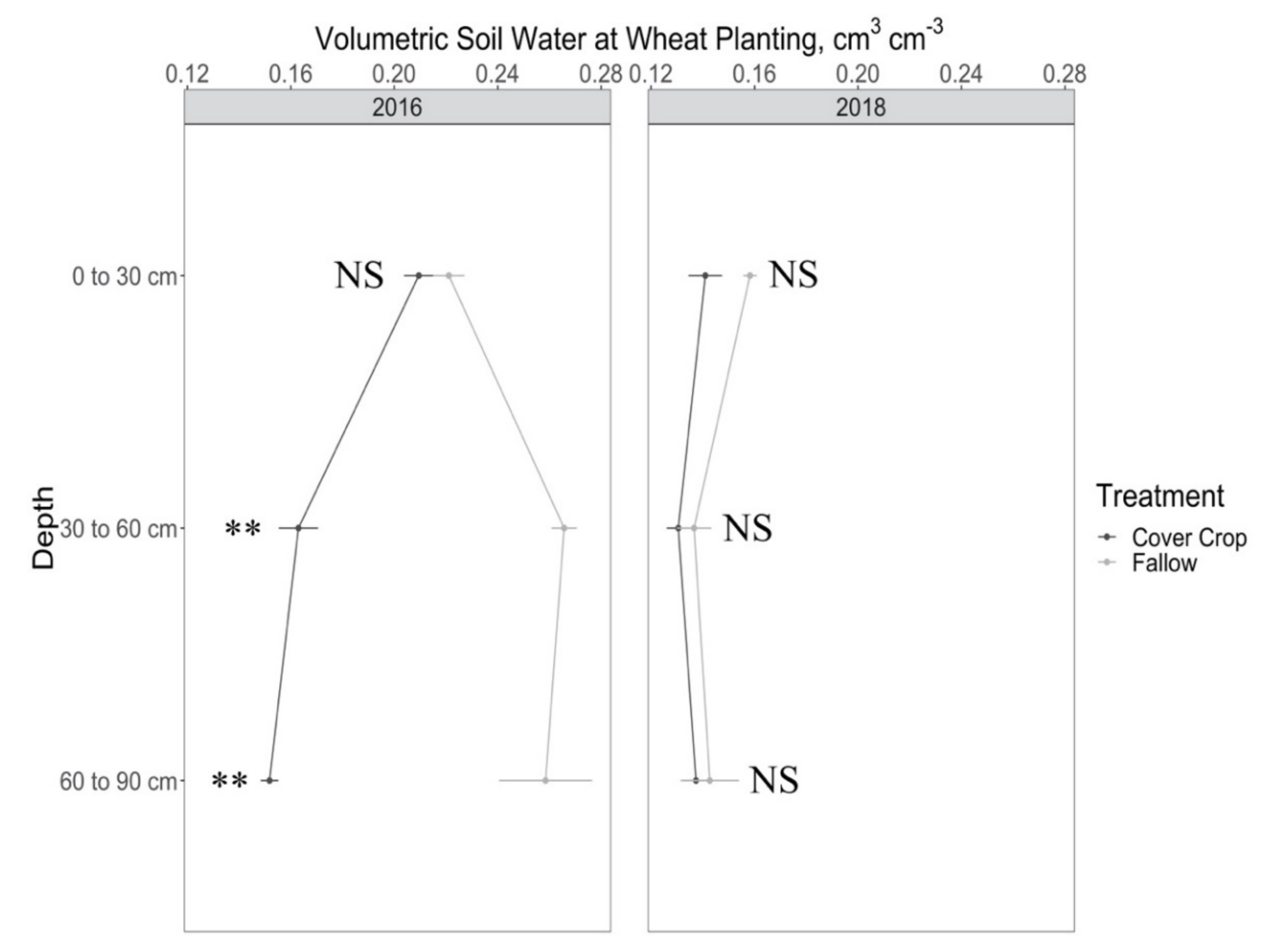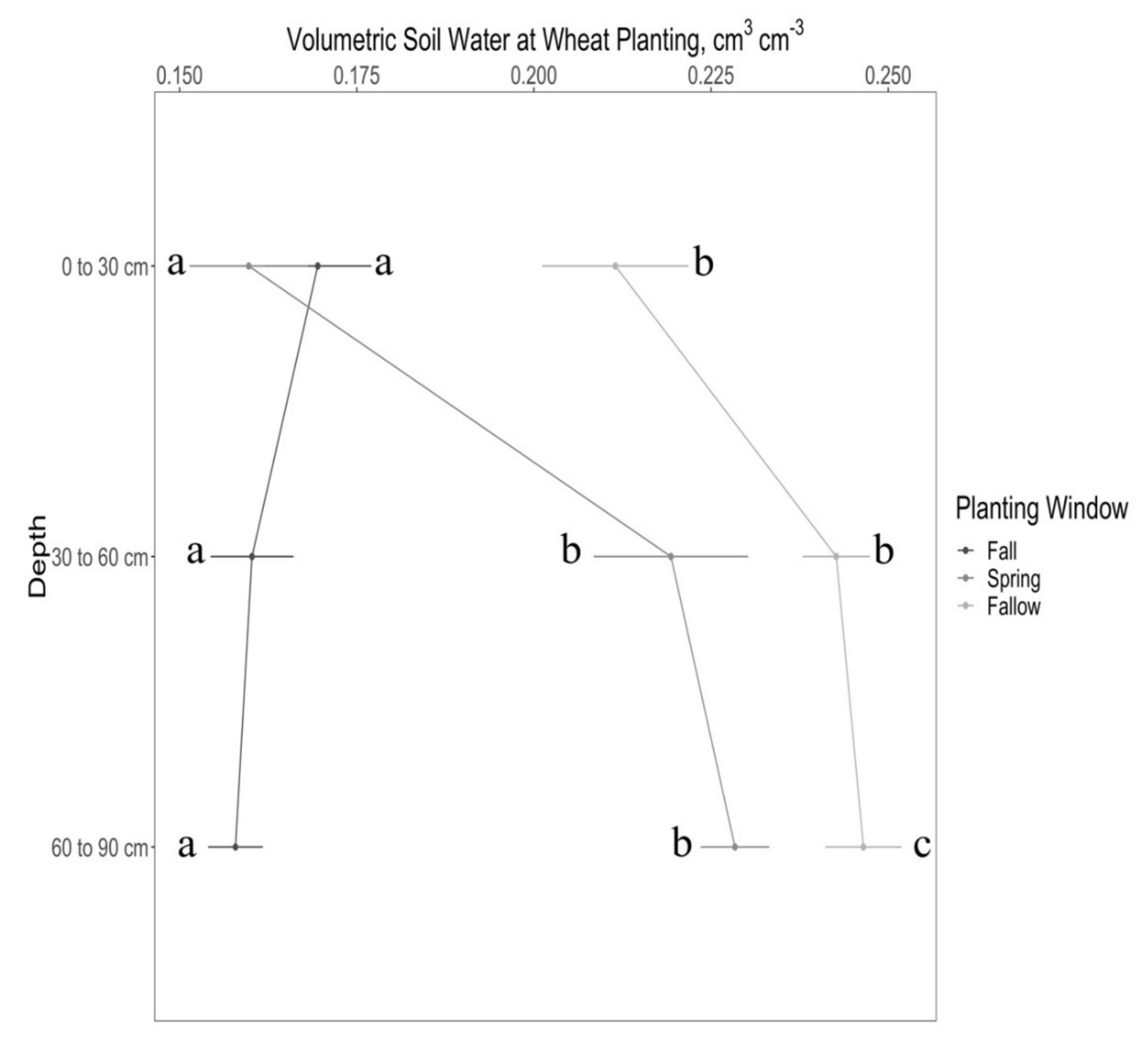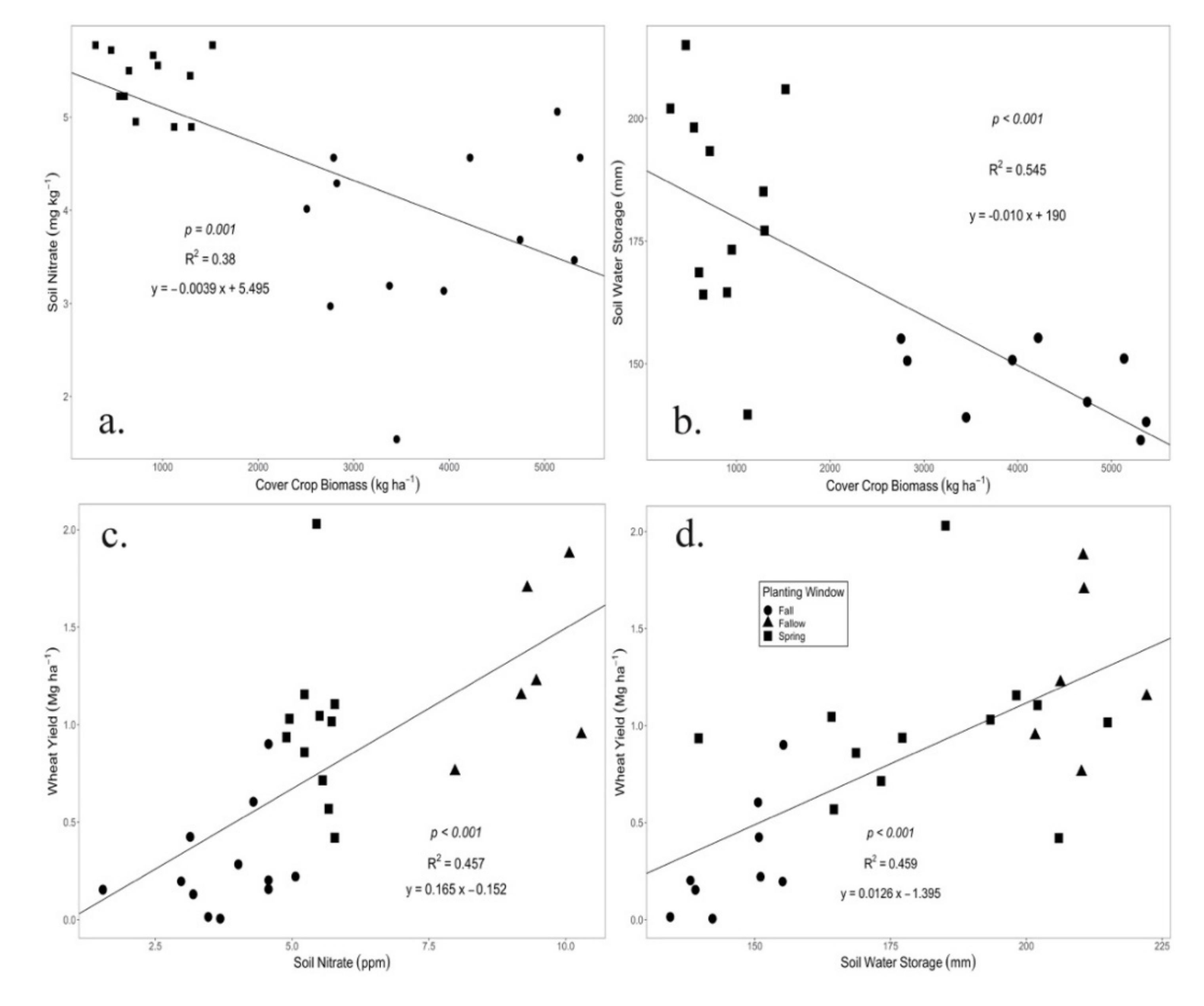Cover Crop Impacts on Water Dynamics and Yields in Dryland Wheat Systems on the Colorado Plateau
Abstract
1. Introduction
- Evaluate the early effects of cover crops vs. bare fallow on soil available N, water dynamics, and wheat yields;
- Assess the potential of different cover crop mixtures and planting windows on cover crop biomass production and associated effects on soil and crop yields;
- Understand how no-till vs. conventional tillage influences various cover crop performance metrics.
2. Materials and Methods
3. Results
3.1. Cover Crop Biomass
3.1.1. Trial 1
3.1.2. Trial 2
3.2. Winter Wheat Yields
3.2.1. Trial 1
3.2.2. Trial 2
3.3. Soil Water and Soil Nitrate
3.3.1. Trial 1
3.3.2. Trial 2
4. Discussion
4.1. Cover Crop Biomass Production and Trade-Offs with Wheat Yields
4.2. Available Soil N and Soil Water as Drivers of Wheat Yield
5. Conclusions
Author Contributions
Funding
Institutional Review Board Statement
Informed Consent Statement
Data Availability Statement
Acknowledgments
Conflicts of Interest
References
- Schwinning, S.; Belnap, J.; Bowling, D.R.; Ehleringer, J.R. Sensitivity of the Colorado Plateau to change: Climate, ecosystems, and society. Ecol. Soc. 2008, 13, 28. [Google Scholar] [CrossRef]
- Smika, D.E. Summer fallow for dryland winter wheat in the semiarid Great Plains. Agron. J. 1970, 62, 15–17. [Google Scholar] [CrossRef]
- Blanco-Canqui, H.; Stone, L.R.; Stahlman, P.W. Soil response to long-term cropping systems on an Argiustoll in the central Great Plains. Soil Sci. Soc. Am. J. 2010, 74, 602–611. [Google Scholar] [CrossRef]
- Natural Resources Conservation Service. National Resources Inventory (Summary Report); Natural Resources Conservation Service and Center for Survey Statistics and Methodology: Washington, DC, USA, 2015.
- Seager, R.; Ting, M.; Held, I.; Kushnir, Y.; Lu, J.; Vecchi, G.; Huang, H.P.; Harnik, N.; Leetmaa, A.; Lau, N.C.; et al. Model projections of an imminent transition to a more arid climate in southwestern North America. Science 2007, 316, 1181–1184. [Google Scholar] [CrossRef] [PubMed]
- Alewoye Getie, M.; Legesse, S.A.; Mekonnen, M.; Aschalew, A. Soil properties and crop productivity strategies as a potential climate variability adaptation options in Adefwuha Watershed, Ethiopia. Earth Syst. Environ. 2020, 4, 359–368. [Google Scholar] [CrossRef]
- Snapp, S.S.; Swinton, S.M.; Labarta, R.; Mutch, D.; Black, J.R.; Leep, R.; Nyiranez, J.; O’Neil, K. Evaluating cover crops for benefits, costs and performance within cropping system niches. Agron. J. 2005, 97, 322–332. [Google Scholar] [CrossRef]
- Schipanski, M.E.; Barbercheck, M.; Douglas, M.R.; Finney, D.M.; Haider, K.; Kaye, J.P.; Kemanian, A.R.; Mortensen, D.A.; Ryan, M.R.; Tooker, J.; et al. A framework for evaluating ecosystem services provided by cover crops in agroecosystems. Agric. Syst. 2014, 125, 12–22. [Google Scholar] [CrossRef]
- Ruis, S.J.; Blanco-Canqui, H. Cover crops could offset crop residue removal effects on soil carbon and other properties: A review. Agron. J. 2017, 109, 1785–1805. [Google Scholar] [CrossRef]
- Miguez, F.E.; Archontoulis, S.; Basche, A.D. Predicting Long-Term Cover Crop Impacts on Soil Quality Using a Cropping Systems Model (2016 Project Summaries); Leopold Center for Sustainable Agriculture, Iowa State University: Ames, IA, USA, 2016; Available online: http://lib.dr.iastate.edu/leopold_grantreports/504 (accessed on 11 February 2021).
- Basche, A.D.; DeLonge, M.S. Comparing infiltration rates in soils managed with conventional and alternative farming methods: A meta-analysis. PLoS ONE 2019, 14. [Google Scholar] [CrossRef]
- Nielsen, D.C.; Vigil, M.F. Intensifying a semi-arid dryland crop rotation by replacing fallow with pea. Agric. Water Manag. 2017, 186, 127–138. [Google Scholar] [CrossRef]
- Unger, P.W.; Vigil, M.F. Cover crop effects on soil water relationships. J. Soil Water Conserv. 1998, 53, 200–207. [Google Scholar]
- U.S. Geological Survey. Precipitation History of the Colorado Plateau Region, 1900–2000 (Fact Sheet 119-02); U.S. Geological Survey: Flagstaff, AZ, USA, 2002. Available online: https://pubs.usgs.gov/fs/2002/fs119-02/ (accessed on 11 February 2021).
- Soil Survey Staff. Web Soil Survey; National Resources Conservation Service, United States Department of Agriculture: Washington, DC, USA, 2020. Available online: http://www.websoilsurvey.nrcs.usda.gov/ (accessed on 11 February 2021).
- Berrada, A.F. Southwestern Colorado Research Center 2012 Results (Technical Report); Colorado State University: Yellow Jacket, CO, USA, 2012; Available online: https://mountainscholar.org/bitstream/handle/10217/80656/CAES_tr13-8.pdf?sequence=1&isAllowed=y (accessed on 11 February 2021).
- Keeney, D.R.; Nelson, D.W. Nitrogen—inorganic forms. In Methods of Soil Analysis: Part. 2 Chemical and Microbiological Properties, 2nd ed.; American Society of Agronomy: New York, NY, USA, 1983; pp. 643–698. [Google Scholar] [CrossRef]
- Lenth, R.; Singmann, H.; Love, J.; Buerkner, P.; Herve, M. Emmeans: Estimated marginal means, aka least-squares means. R Package Version 2018, 1, 3. [Google Scholar]
- R Core Team. R: A Language and Environment for Statistical Computing; R Core Team: Vienna, Austria, 2013. [Google Scholar]
- Kelly, C.; Schipanski, M.E.; Tucker, A.; Trujillo, W.; Holman, J.D.; Obour, A.K.; Johnson, S.K.; Brummer, J.E.; Haag, L.; Fonte, S.J. Dryland cover crop soil health benefits are maintained with grazing in the US High and Central Plains. Agric. Ecosyst. Environ. 2021, 313. [Google Scholar] [CrossRef]
- Nielsen, D.C.; Lyon, D.J.; Hergert, G.W.; Higgins, R.K.; Calderón, F.J.; Vigil, M. Cover crop mixtures do not use water differently than single-species plantings. Agron. J. 2015, 107, 1025–1038. [Google Scholar] [CrossRef]
- Tilman, D.; Reich, P.B.; Knops, J.; Wedin, D.; Mielke, T.; Lehman, C. Diversity and productivity in a long-term grassland experiment. Science 2001, 294, 843–845. [Google Scholar] [CrossRef]
- Finney, D.M.; White, C.M.; Kaye, J.P. Biomass production and carbon/nitrogen ratio influence ecosystem services from cover crop mixtures. Agron. J. 2016, 108, 39–52. [Google Scholar] [CrossRef]
- Florence, A.M.; Higley, L.G.; Drijber, R.A.; Francis, C.A.; Lindquist, J.L. Cover crop mixture diversity, biomass productivity, weed suppression, and stability. PLoS ONE 2019, 14. [Google Scholar] [CrossRef]
- Colorado Agricultural Statistics Service. Colorado Agricultural Statistics, 2016–2017; National Agricultural Statistics Service and Colorado Department of Agriculture: Lakewood, CO, USA, 2018.
- Colorado Agricultural Statistics Service. Colorado Agricultural Statistics, 2017–2018; National Agricultural Statistics Service and Colorado Department of Agriculture: Lakewood, CO, USA, 2019.
- Colorado Agricultural Statistics Service. Colorado Agricultural Statistics, 2018–2019; National Agricultural Statistics Service and Colorado Department of Agriculture: Lakewood, CO, USA, 2020.
- Nielsen, D.C.; Vigil, M.F. Legume green fallow effect on soil water content at wheat planting and wheat yield. Agron. J. 2005, 97, 684–689. [Google Scholar] [CrossRef]
- Nielsen, D.C.; Lyon, D.J.; Higgins, R.K.; Hergert, G.W.; Holman, J.D.; Vigil, M.F. Cover crop effect on subsequent wheat yield in the central Great Plains. Agron. J. 2016, 108, 243–256. [Google Scholar] [CrossRef]
- Finney, D.M.; Kaye, J.P. Functional diversity in cover crop polycultures increases multifunctionality of an agricultural system. J. Appl. Ecol. 2017, 54, 509–517. [Google Scholar] [CrossRef]
- Kumar, V.; Obour, A.; Jha, P.; Liu, R.; Manuchehri, M.R.; Dille, J.A.; Holman, J.; Stahlman, P.W. Integrating cover crops for weed management in the semiarid US Great Plains: Opportunities and challenges. Weed Sci. 2020, 68, 311–323. [Google Scholar] [CrossRef]
- Holman, J.D.; Arnet, K.; Dille, J.; Maxwell, S.; Obour, A.; Roberts, T.; Roozeboom, K.; Schlegel, A. Can cover or forage crops replace fallow in the semiarid Central Great Plains? Crop Sci. 2018, 58, 932–944. [Google Scholar] [CrossRef]
- Miller, P.R.; Engel, R.E.; Holmes, J.A. Cropping sequence effect of pea and pea management on spring wheat in the northern Great Plains. Agron. J. 2006, 98, 1610–1619. [Google Scholar] [CrossRef]
- Baraibar, B.; Hunter, M.C.; Schipanski, M.E.; Hamilton, A.; Mortensen, D.A. Weed suppression in cover crop monocultures and mixtures. Weed Sci. 2018, 66, 121–133. [Google Scholar] [CrossRef]
- Lyon, D.J.; Nielsen, D.C.; Felter, D.G.; Burgener, P.A. Choice of summer fallow replacement crops impacts subsequent winter wheat. Agron. J. 2007, 99, 578–584. [Google Scholar] [CrossRef]
- Nielsen, D.C.; Anderson, R.L.; Bowman, R.A.; Aiken, R.M.; Vigil, M.F.; Benjamin, J.G. Winter wheat and proso millet yield reduction due to sunflower in rotation. J. Prod. Agric. 1999, 12, 193–197. [Google Scholar] [CrossRef]
- Nielsen, D.C.; Vigil, M.F.; Anderson, R.L.; Bowman, R.A.; Benjamin, J.G.; Halvorson, A.D. Cropping system influence on planting water content and yield of winter wheat. Agron. J. 2002, 94, 962–967. [Google Scholar] [CrossRef]
- Schlegel, A.J.; Havlin, J.L. Green fallow for the central Great Plains. Agron. J. 1997, 89, 762–767. [Google Scholar] [CrossRef]
- Burgess, M.; Miller, P.; Jones, C.; Bekkerman, A. Tillage of cover crops affects soil water, nitrogen, and wheat yield components. Agron. J. 2014, 106, 1497–1508. [Google Scholar] [CrossRef]
- Thorup-Kristensen, K. The effect of nitrogen catch crops on the nitrogen nutrition of a succeeding crop: I. Effects through mineralization and pre-emptive competition. Acta Agric. Scand. B. Soil Plant. Sci. 1993, 43, 74–81. [Google Scholar] [CrossRef]
- Helgason, B.L.; Gregorich, E.G.; Janzen, H.H.; Ellert, B.H.; Lorenz, N.; Dick, R.P. Long-term microbial retention of residue C is site-specific and depends on residue placement. Soil Biol. Biochem. 2014, 68, 231–240. [Google Scholar] [CrossRef]
- Thomas, B.W.; Larney, F.J.; Chantigny, M.H.; Goyer, C.; Hao, X. Fall rye reduced residual soil nitrate and dryland spring wheat grain yield. Agron. J. 2017, 109, 718–728. [Google Scholar] [CrossRef][Green Version]
- Kirkegaard, J.A.; Ryan, M.H. Magnitude and mechanisms of persistent crop sequence effects on wheat. Field Crops Res. 2014, 164, 154–165. [Google Scholar] [CrossRef]
- Ranaivoson, L.; Naudin, K.; Ripoche, A.; Affholder, F.; Rabeharisoa, L.; Corbeels, M. Agro-ecological functions of crop residues under conservation agriculture. A review. Agron. Sustain. Dev. 2017, 37, 26. [Google Scholar] [CrossRef]




| Trial 1 | |||
|---|---|---|---|
| Cover Crop Treatment | Cover Crop Seeding Rate (kg ha−1) | Species | |
| Mix 1 | 32.4 | Hairy Vetch a (14%), Yellow Sweet Clover b (3%), Winter Pea c (83%) | |
| Mix 2 | 39.5 | Hairy Vetch (8%), Yellow Sweet Clover (2%), Winter Pea (48%), Winter Rye d (43%) | |
| Mix 3 | 31.7 | Hairy Vetch (6%), Yellow Sweet Clover (1%), Winter Pea (34%), Winter Rye (53%), Winfred Turnip e (3%), Winter Canola f (3%) | |
| Fallow | NA | Fallow-Control | |
| Trial 2 | |||
| Cover Crop Treatment | Planting Window | Cover Crop Seeding Rate (kg ha−1) | Species |
| Mix 1 | Fall | 27.7 | Winter Pea (54%), g Berseem Clover (4%), Yellow Sweet Clover (1%), h Winter Barley (35%), i Forage Radish (2.5%), j Forage Turnip (2.5%) |
| Mix 2 | Fall | 37.1 | Winter Pea (55%), k Lentil (5%), Winter Barley (37%), Winter Canola (3%) |
| Mix 3 | Fall | 48.2 | Winter Pea (50%), Hairy Vetch (10%), Winter Barley (17%), Forage Radish (3%), Winter Canola (3%) |
| Mix 4 | Fall | 39.3 | Winter Pea (59%), Hairy Vetch (19%), Winter barley (7.5%), l Winter Oat (7.5%), Forage Radish (2.5%), Winter Canola (2.5%) |
| Mix 5 | Fall | 42.6 | Winter Pea (31%), Hairy Vetch (8%), Winter Barley (27%), Oats (27%), Forage Radish (3%), Winter Canola (3%) |
| Mix 6 | Spring | 27.2 | Hairy Vetch (14%), m Spring Pea (62%), n Spring Oat (16%), Winter Canola (1%), o Flax (2%), p Safflower (4%) |
| Mix 7 | Spring | 11.2 | q Balansa Clover (40%), r Crimson Clover (20%), s Ryegrass (30%), Forage radish (10%) |
| Mix 8 | Spring | 25.1 | Crimson Clover (2%), Spring Pea (67%), t Spring Barley (25%), Forage radish (7%) |
| Fallow | NA | NA | Fallow-Control |
| Trial | ||
|---|---|---|
| T1 | T2 | |
| Cover Crop Cycle 1 Planting Date | Sept. 28, 2015 | Fall-planted: Aug. 11, 2016 Spring-planted: Apr. 13, 2017 |
| Cover Crop Cycle 1 Termination Date | June 10, 2016 | June 20, 2017 |
| Winter Wheat Cycle 1 Planting Date | Sept. 19, 2016 | Sept. 21, 2017 |
| Winter Wheat Cycle 1 Harvest Date | June 20, 2017 | July 25, 2018 |
| Cover Crop Cycle 2 Planting Date | Aug. 30, 2017 | NA 1 |
| Cover Crop Cycle 2 Termination Date | June 8, 2018 | NA |
| Winter Wheat Cycle 2 Planting Date | Sept. 28, 2018 | NA |
| Winter Wheat Cycle 2 Harvest Date | Aug. 7, 2019 | NA |
| Growing Season | ||||||||
|---|---|---|---|---|---|---|---|---|
| 2015–2016 | 2016–2017 | 2017–2018 | 2018–2019 | |||||
| Month | T | P | T | P | T | P | T | P |
| °C | mm | °C | mm | °C | mm | °C | mm | |
| August | 20.8 | 26.9 | 18.8 | 45.0 | 20.0 | 14.5 | 21.2 | 6.6 |
| September | 18.1 | 25.4 | 15.7 | 26.4 | 16.1 | 44.7 | 18.1 | 27.9 |
| October | 11.8 | 36.6 | 12.1 | 1.5 | 10.4 | 1.0 | 8.7 | 60.5 |
| November | 1.9 | 34.5 | 5.7 | 27.7 | 7.5 | 2.5 | 2.3 | 5.8 |
| December | −3.1 | 11.2 | −1.6 | 40.9 | 2.2 | 0.3 | −2.4 | 15.2 |
| January | −4.3 | 23.4 | −2.7 | 36.8 | 0.9 | 15.2 | −3.8 | 22.9 |
| February | NA 1 | NA | 2.2 | 21.3 | 0.7 | 9.9 | −4.2 | 23.4 |
| March | 5.0 | 6.4 | 6.6 | 17.8 | 4.1 | 4.8 | 2.9 | 55.9 |
| April | 7.3 | 15.7 | 7.2 | 11.2 | 9.4 | 8.4 | 9.2 | 27.4 |
| May | 11.2 | 33.8 | 11.8 | 27.4 | 14.7 | 21.6 | 9.1 | 47.8 |
| June | 20.8 | 1.5 | 20.3 | 0.0 | 20.2 | 8.6 | 17.2 | 22.9 |
| July | 21.7 | 61.5 | 21.7 | 58.4 | 22.5 | 27.2 | 21.2 | 6.6 |
| Total P | 276.9 | 314.4 | 158.7 | 316.3 | ||||
| 2016–2017 Cycle | 2018–2019 Cycle | |||||||||
|---|---|---|---|---|---|---|---|---|---|---|
| Cover Crop Treatment | Cover Crop Biomass | Soil Nitrate | Soil Water Storage | Wheat Yield | Wheat Protein | Cover Crop Biomass | Soil Nitrate | Soil Water Storage | Wheat Yield | Wheat Protein |
| kg ha−1 | mg kg−1 | mm | Mg ha−1 | % Crude Protein | kg ha−1 | mg kg−1 | mm | Mg ha−1 | % Crude Protein | |
| Mix 1 | 4560 a | 9.68 a | 157 a | 3.00 a | 13.7 a | 1410 a | 13.6 ab | 129 a | 1.57 a | 10.0 a |
| Mix 2 | 4860 a | 10.2 a | 151 a | 3.01 a | 13.7 a | 1570 a | 11.0 a | 120 a | 1.47 ab | 9.2 a |
| Mix 3 | 5650 a | NE 1 | 163 a | 2.82 a | 14.0 a | 1550 a | 12.7 a | 119 a | 1.51 ab | 8.7 a |
| Fallow | NE | 17.1 b | 224 b | 4.03 b | 15.0 a | NE | 19.4 b | 131 a | 1.35 b | 8.8 a |
| ANOVA 2 | ||||||||||
| 0.60 | 0.005 | 0.010 | <0.0001 | 0.099 | 0.60 | 0.013 | 0.38 | 0.028 | 0.097 | |
| Orthogonal Contrasts 3 | ||||||||||
| NA 4 | 0.002 | 0.003 | <0.0001 | 0.023 | NA | 0.0028 | 0.23 | 0.008 | 0.26 | |
| Cover Crop Planting Window | Cover Crop Treatment | Tillage | Cover Crop Biomass | Soil Nitrate | Soil Water Storage | Wheat Yield |
|---|---|---|---|---|---|---|
| kg ha−1 | mg kg−1 | mm | Mg ha−1 | |||
| Fall | Mix 1 | CT 1 | 3620 ab | 3.28 a | 149 abc | 0.11 ab |
| NT 2 | 4120 a | 4.57 ab | 147 ab | 0.42 abcd | ||
| Mix 2 | CT | 3570 ab | NE 3 | NE | 0.08 a | |
| NT | 3940 a | NE | NE | 0.34 abcd | ||
| Mix 3 | CT | 3660 ab | NE | NE | 0.22 abc | |
| NT | 3840 a | NE | NE | 0.41 abcd | ||
| Mix 4 | CT | 4490 a | NE | NE | 0.14 abc | |
| NT | 3520 ab | NE | NE | 0.59 abcde | ||
| Mix 5 | CT | 3760 ab | 3.01 a | 137 a | 0.15 abc | |
| NT | 3970 a | 4.16 ab | 151 ab | 0.42 abcd | ||
| Spring | Mix 6 | CT | 855 c | 5.39 b | 177 abcd | 0.77 abcdef |
| NT | 742 c | 5.37 b | 173 abcd | 1.00 bcdef | ||
| Mix 7 | CT | 556 c | NE | NE | 0.81 bcdef | |
| NT | 440 c | NE | NE | 1.24 ef | ||
| Mix 8 | CT | 1120 bc | 5.30 b | 194 bcd | 0.84 cdef | |
| NT | 728 c | 5.48 b | 185 abcd | 1.33 f | ||
| Fallow | CT | NA4 | 9.15 c | 211 d | 0.95 def | |
| NT | NA | 9.61 c | 209 cd | 1.60 f | ||
| ANOVA 5 | ||||||
| Source of variation | ||||||
| Cover Crop Treatment | <0.001 | <0.001 | <0.001 | <0.001 | ||
| Tillage Treatment | 1.00 | 0.129 | 0.880 | 0.102 | ||
| Cover Crop x Tillage | 0.86 | 0.377 | 0.740 | 0.738 | ||
| Orthogonal Contrasts 6 | ||||||
| Planting Window Comparison | ||||||
| Fall- vs. spring-planted | <0.001 | <0.001 | 0.201 | <0.001 | ||
| Fall-planted vs. fallow | NA | <0.001 | <0.001 | <0.001 | ||
| Spring-planted vs. fallow | NA | <0.001 | <0.001 | 0.014 | ||
Publisher’s Note: MDPI stays neutral with regard to jurisdictional claims in published maps and institutional affiliations. |
© 2021 by the authors. Licensee MDPI, Basel, Switzerland. This article is an open access article distributed under the terms and conditions of the Creative Commons Attribution (CC BY) license (https://creativecommons.org/licenses/by/4.0/).
Share and Cite
Eash, L.; Berrada, A.F.; Russell, K.; Fonte, S.J. Cover Crop Impacts on Water Dynamics and Yields in Dryland Wheat Systems on the Colorado Plateau. Agronomy 2021, 11, 1102. https://doi.org/10.3390/agronomy11061102
Eash L, Berrada AF, Russell K, Fonte SJ. Cover Crop Impacts on Water Dynamics and Yields in Dryland Wheat Systems on the Colorado Plateau. Agronomy. 2021; 11(6):1102. https://doi.org/10.3390/agronomy11061102
Chicago/Turabian StyleEash, Lisa, Abdel F. Berrada, Kathleen Russell, and Steven J. Fonte. 2021. "Cover Crop Impacts on Water Dynamics and Yields in Dryland Wheat Systems on the Colorado Plateau" Agronomy 11, no. 6: 1102. https://doi.org/10.3390/agronomy11061102
APA StyleEash, L., Berrada, A. F., Russell, K., & Fonte, S. J. (2021). Cover Crop Impacts on Water Dynamics and Yields in Dryland Wheat Systems on the Colorado Plateau. Agronomy, 11(6), 1102. https://doi.org/10.3390/agronomy11061102






